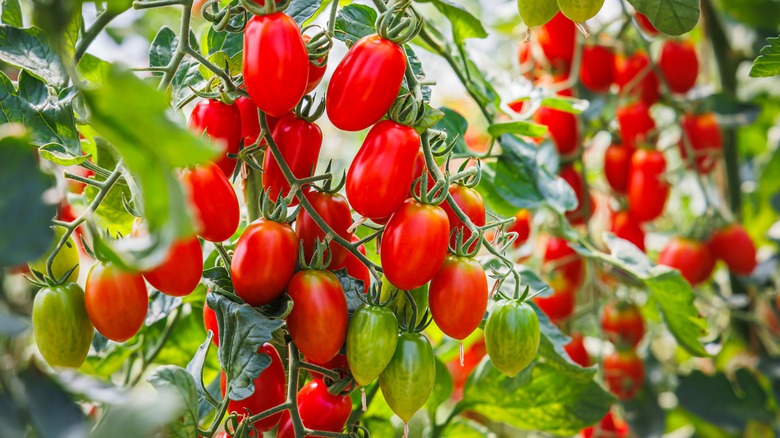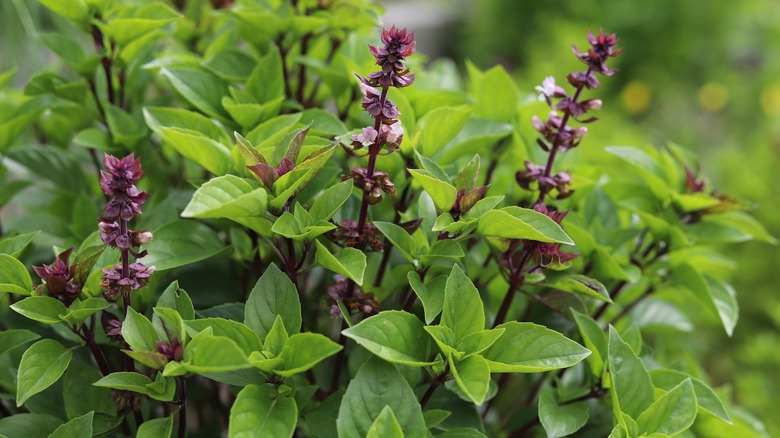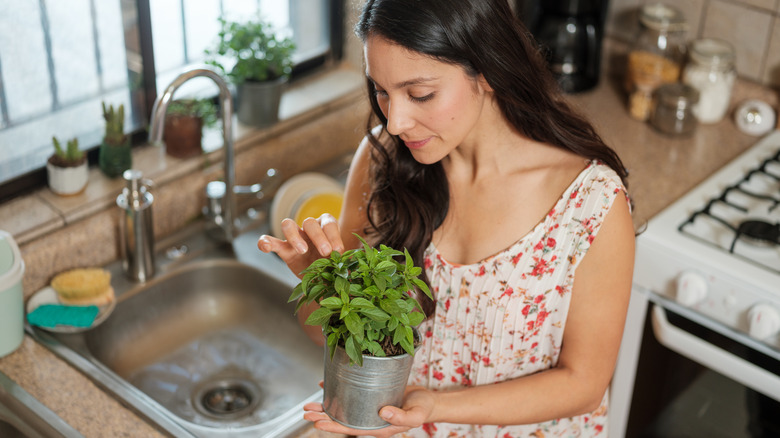The Fast-Growing Type Of Basil You'll Want To Grow Near Your Tomatoes
Some things are simply meant to be together, and a fab combination you might not be aware of could be the key to your tomato garden's health (in addition to other benefits). The practice of placing certain fruits, vegetables, or herbs next to other plant species in the garden is known as companion planting. Companion planting has been around for thousands of years and always centers around the idea that plants can work together to promote their collective health and benefit your garden as a whole. Such is the case with cinnamon basil and tomatoes. If you're going to grow this plant in your garden, however, you first need to know its needs in order to achieve optimal growth.
Fortunately, cinnamon basil is touted for being easy to care for and fast-growing, so long as it has the right conditions. This type of basil grows well in USDA zones 4a-10b. Position your cinnamon basil plant in full sun and ensure that whatever container it is in sufficiently drains; these plants want a slightly-moist soil, but you should avoid making it overly saturated. Refreshing your knowledge on the best method for watering your basil plants can help you strike the right moisture balance. Remember that properly pruning this herb will lead to a healthier and more robust growth pattern. If left to go to seed, you may see the cinnamon basil plant cropping up elsewhere in your yard next year.
The many benefits of cinnamon basil
This somewhat elusive basil variety can be a game-changer for the well-being of your tomatoes, as it will keep pests away from your juicy, red produce. One of the most noticeable characteristics of cinnamon basil is the strong smell it gives off, which is highly unpleasant to tomato-destroying pests like aphids, tomato hornworms, and certain flies. Due to its strong scent, cinnamon (as well as lemon basil) is thought to be better at keeping pests away than common basil.
In addition to its pest-deterring properties, cinnamon basil's fragrant flowers are excellent pollinator attractors, drawing bees and butterflies to your tomato garden. Your cinnamon basil plant is most likely to attract pollinators when it bolts (though, certain species of bees have been known to be attracted to plants for their leaves or oils). And while tomatoes are self-pollinating plants, there is no harm in sending a little bit of help their way. Some gardeners even credit the addition of basil to their tomato garden for an increased yield and better-tasting tomatoes. Since cinnamon basil is known for its speed in growth, you can start yielding its benefits quickly; however, its fast growth may lead to it becoming too spindly if not pruned periodically.
Beyond the tomato garden
Cinnamon basil is one of over 150 basil varieties in existence today, though many people in America only know of sweet basil, the type that is found in many Italian recipes. Even if you are not a grower of tomatoes, cinnamon basil can still be a beneficial plant to add to your property. Thanks to its fragrant aroma, mosquitoes will find the plant perturbing and take their blood-sucking endeavors elsewhere. In fact, it may be worthwhile to consider planting this basil variety around your patio or outdoor living space to give your family and pets a safe haven from pesky mosquitoes (essentially creating a basil barrier to keep pests at bay).
For best results, purchase the cinnamon basil plants from a nursery (to cut out the growing time from seed) and install it in your garden after the last frost. It should thrive until the temperatures begin to drop in the fall. While your cinnamon basil plant will die off and need to be replanted, its speed in growth means that you won't have to go too long without it.


